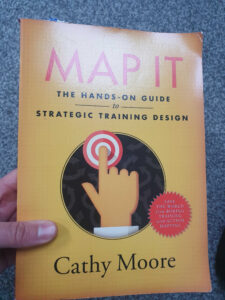Map it! Reframing Your Training Design
Subject experts should be in the business of creating change.
Your services are not desired because of what you know, but because of the transformation your knowledge can unlock.
If this is the case, it’s a missed opportunity that many training courses are still focused on sharing knowledge. I’ve sat in countless training rooms where lectures, slide decks, and information dumps dominate, while opportunities for practical application often take a backseat.
One of the most pivotal books I’ve read on this subject is Map It: The hands-on guide to strategic training design by Cathy Moore. Her approach is well known within e-learning circles but seems to be less recognised in training and education more widely.

Moore’s central premise is simple but powerful: training should be designed to achieve tangible outcomes, not just deliver information.
Her ‘action-mapping’ approach turns traditional training design on its head by asking the critical question, “What do learners need to do?” rather than “What do learners need to know?”.
It’s a small and subtle reframe that has far-reaching effects.
Moore’s action mapping process starts with a clear focus on desired performance outcomes. She challenges you to identify:
- What is the real-world behaviour that needs to change?
- What actions must learners take to achieve that change?
- How can we measure that change?
Once you’ve identified what you want to change, training activities are designed specifically (and exclusively) to support those actions. Everything else is stripped away, leaving only what truly matters.
The value of this approach lies in how deeply it connects learning to real-world contexts. Instead of focusing on abstract knowledge, subject experts can use scenario-based learning, role-playing exercises, and practical challenges that mirror what learners will face on the job or in life. After all, this is where your audience will need their new capabilities!
Naturally, Cathy Moore’s website outlines her approach better than we ever could. So we’ll leave it to her to explain more.
But if you want to create better outcomes in your training, here are some steps to get started:
- Dig deeper into your client’s request. Why do they really want your help? What outcome do they want? What does this look like in reality? What stops them from achieving this themselves?
- Design your training around actionable outcomes. Identify the specific behaviours or skills you want participants to develop, then design activities that mirror real-world situations.
- Review your workshop slides. Are they full of information or instructions/guidance for activities? How can you do less of the former and more of the latter?
- Support your learners beyond the core intervention. Developing any new skill takes time, practice and feedback. Give your client the support they need (e.g. resources or nudge emails) to keep this on the radar.
- Finally, grab a copy of ‘Map it’ and put it into action…
I hope this helps you design more impactful training.
Fresh insights direct to your inbox
Join the Candle Digital mailing list




